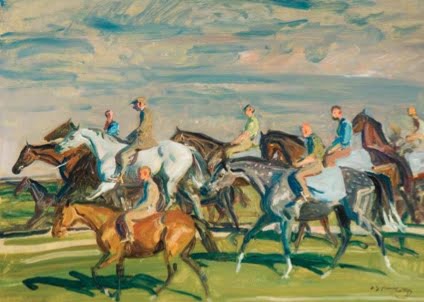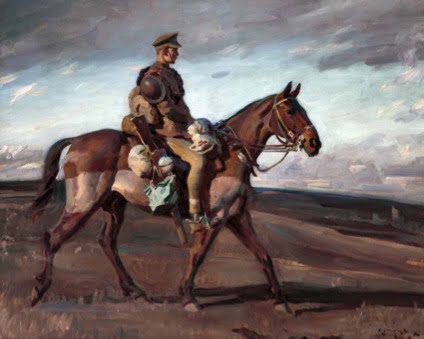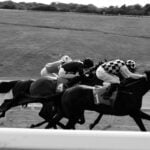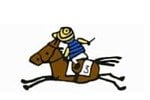The work of artist Sir Alfred Munnings, British Impressionist and famous painter of horses, horseracing and country life, is being presented at The National Horseracing Museum, Newmarket, 24th May–12th June, in a major exhibition.
Sir Alfred Munnings (1878–1959) ‘A Life of his Own’, organised by The British Sporting Art Trust whose home is in Palace House – part of the overall Museum complex.
The exhibition comprises some forty paintings, watercolours and drawings spanning sixty years of the artist’s career. Munnings was one of the most popular and successful artists of his generation and the selected works tell the story of his rise from his early years working in rural Suffolk and Norfolk to his election as President of the Royal Academy in 1944. Generous loans have been secured from public and private collections and thanks go to the Jockey Club, Atkinson Art Gallery, The Harewood House Trust and The Household Cavalry Mounted Regiment for their support.
Some of these works have never been exhibited before.
Every Picture Tells a Story

Lord Derby’s Horses Hyperion and Fairway with their Grooms Chinnery and Cain, 1938. Oil on panel, 50.8 x 61 cm (20 x 24 in.), Inscribed lower left: A J Munnings – Private Collection
Pictured: In 1938 Munnings was commissioned to paint two champion sires owned by Edward Stanley, 17th Earl of Derby (1865 – 1948), at his Woodland Stud in Newmarket. He vividly described the experience in his autobiography: “The stud-farm where Hyperion and Fairway dwelt in adjoining boxes, if it were advertised in a journal read by horses might be described as a large two roomed flat, on the ground-floor, in ideal surroundings.” Munnings enjoyed painting him and described him as “a beautiful little horse, not an Araby head; but he was far beyond the average horse in intelligence. Chinery, his man, adored him, and looked upon him as a brother.”
Hyperion’s career embraced major wins in the New Stakes (Ascot 1932), Dewhurst Stakes (Newmarket 1932), Prince of Wales Stakes (Ascot 1933), Chester Vase (1933), Epsom Derby (1933) and St Leger Stakes (Doncaster 1933), before going on to a stellar stud career.

Study of Buchan, 1920. Oil on board, 43.1 x 53.3 cm, (17 x 21 in.), Inscribed lower center: Manton / Buchan / Oct 23rd 1920. A.J. Munnings – Lent by the Board of Directors of Jockey Club Estates Ltd. (no. 55)
Pictured is Buchan. Belonging to Lord Astor, Buchan won the Eclipse at Sandown Park twice (1919 and 1920) and the Champion Stakes at Ascot (1919). He also finished 1st in the Ascot Gold Cup in 1920 but was disqualified! The study provides a fascinating insight into the artist’s working methods. He made notations on the picture in pencil indicating the colours to be used for the highlights on the horse. Greens and violets seem remarkable colours to depict accurately the sheen of a horse’s coat in sunshine, and the combination was also mentioned by Munnings’ contemporary and fellow war artist William Orpen.

Exercising the Horses, c. 1950. Oil on panel, 45.7 x 61 cm (18 x 24 in.), Inscribed lower right: A.J. Munnings – The Munnings Art Museum (no. 266)
When staying in Newmarket Munnings went each morning to Warren Hill to watch the morning training sessions. He evoked the atmosphere in his autobiography, a scene which would be familiar on and around the great racecourses up and down the land: “Hooves sounding on streets and roads…Hooves sounding in stable yards as horses come and go; and seated on their backs, old men, middle-aged men, young men, girls, little lads in jodphurs, leggings, trousers … the laziest, with longest hair mostly wear trousers. All these figures of men and boys are picturesque, heroic even.”

Trooper in Full Marching Order, c. 1918. Oil on canvas, 103 x 127.5 cm (12 x 15 in.) – The Atkinson Art Gallery (SOPAG:849)
Munnings was refused active service in the First World War, having lost sight in his right eye due to a blackthorn piercing it in 1898. Cecil Aldin found him a position in the remount depot at Reading before Paul Konody suggested he be commissioned to join the Canadian Cavalry in France as an official war artist.
This commission changed the course of Munnings’ life and career. Forty five of his paintings were included in the Canadian War Records Exhibition at the Royal Academy in January 1919 and their brilliant reception led to his being elected an Associate Royal Academician and provided the opportunity to paint the people, horses and hounds of the Belvoir hunt.
The exhibition comprises four main themes:
Pursuit of Patronage: This section traces the success of Munnings’ paintings for the Canadian Cavalry during the First World War, which acted as a catalyst for major commissions from the racing and hunting worlds. Included are two works for Major Tommy Bouch of the Belvoir hunt and two for Lord Derby, owner of the legendary Hyperion. Royal portraits will be represented by Princess Mary on Portumna (Newmarket only), which the artist considered one of his finest female portraits.
The Sporting Scene: Munnings captured the elegance and dynamism of the horse like few others and he produced some of the greatest equestrian portraits in the history of British, and, indeed, worlda art. He was greatly valued by the hunting and racing worlds alike. One of the highlights of this section is Edward Turnour, 6th Earl Winterton MFH from the collection of the British Sporting Art Trust.
Painting for Pleasure: Away from the demands of commissions, Munnings spent as much time as possible painting the landscapes and horses he loved most. Included are dramatic views around Withypool on Exmoor and A Shoot in a Swede Field, an early work of his shooting friends in Norwich. The artist spent his final years painting his iconic studies of the starts at Newmarket, where he used the last surviving rubbing house as his studio and one of these has been kindly lent by the Munnings Art Museum.
Symphonies in Grey and White: Munnings loved and was inspired by grey horses and many of his most iconic works feature their diverse colouring. Amongst the most difficult shades to convey on canvas these paintings provided the artist opportunities to highlight his technical bravura with oil paint. Included will be My Grey Mare; one of his most luminous and beautiful studies of a horse as well as unexpected subjects; a detail of the rocky coast of Lamorna in Cornwall, the white Oxen of Baron Rothschild at Chantilly.

Karen can usually be found glued to her computer or at the stables. Having edited several national magazines she co-founded Eclipse Magazine in 2008 after realising that many of her friends were nervous about going racing due to lack of information – what to wear, how to bet etc.
She absolutely loves her job (how many people can say that?!) and is truly grateful to all supporters of and contributors to Eclipse Magazine.
If you are reading this she would like to say THANK YOU! (And please spread the word about Eclipse…!!)





